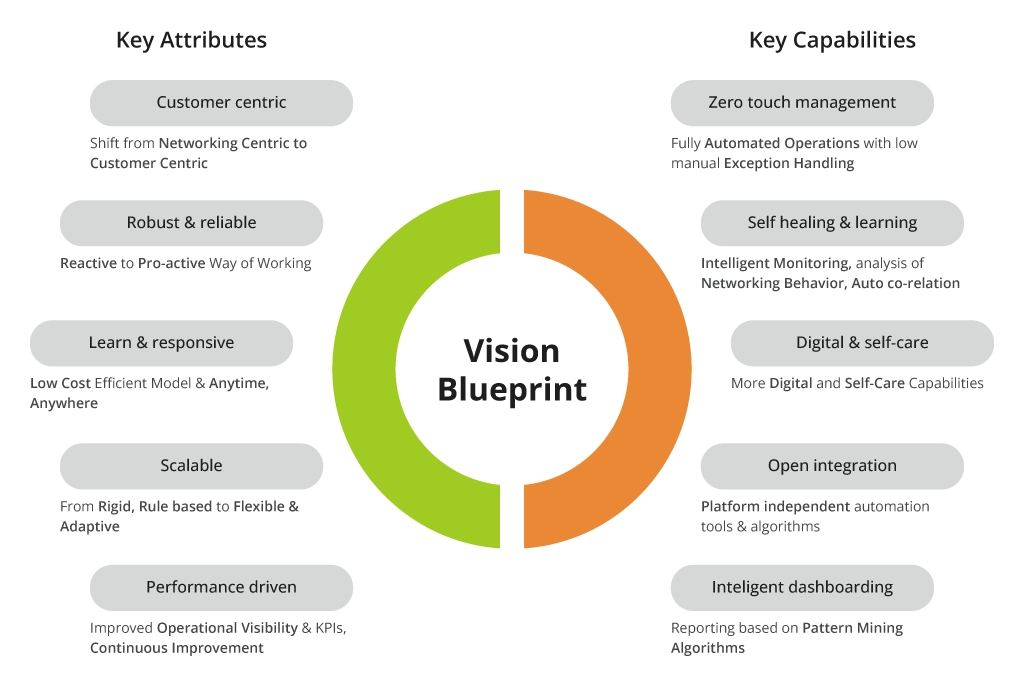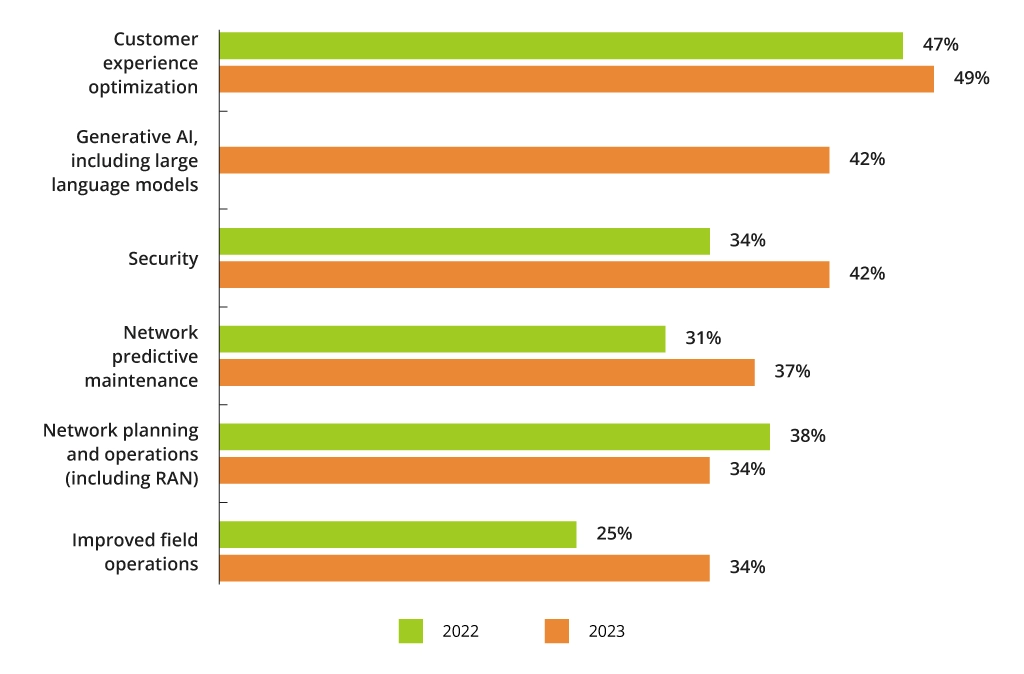Best Practices of Expanding Telecom NOC into Service Monitoring
Broadscale 5G deployments, V2X connectivity, and multiplying IoT use cases have already prompted significant NOC transformations, while future technologies like 6G and quantum computing will further redefine the NOC role.
As telecoms aim to enhance customer experience (CX) and generate more revenue in the highly competitive industry, they turn to new vendors and expand their ecosystems. As a result, companies must adopt advanced monitoring tools and management best practices to counter increasingly complicated NOC monitoring.
Telecom NOC as a Strategic Business Function
To meet evolving consumer demands, telecoms had to enhance networking capabilities to achieve rapid extra bandwidth provisioning, low latency, and 24/7 consistent global performance. Improved service delivery requires better visibility, but many NOC monitoring tools are outdated, lack real-time analytics, and aren’t fully integrated with business systems. Realizing the full benefits of NOCs in this context means leveraging advanced tools and practices to ensure seamless performance.
At present, many NOC monitoring tools are
- Legacy, rule-based systems that lack dynamic automation or self-healing and require manual handling of exceptions and the growing volume of customer queries.
- Missing real-time analytics capabilities, which leads to delayed responses and hinders proactive problem-solving before issues affect service levels.
- Fragmented, lacking integration with business systems, limiting visibility and failing to align network metrics with broader business objectives like customer experience and revenue.
Moreover, telecom network architectures have become more complex due to:
- Higher data processing volumes and variable data types
- Application proliferation in terms of data exchange and consumption
- Extensive cloud service usage by telecom clients
- Progressive virtualization activities including Network Functions Virtualization (NFV) and Software-Defined Networking (SDN).
To effectively monitor and enhance these complex assets, telecoms need more than improved NOC tools — they need better processes and organizational structures.
Vision Blueprint for Future NOCs

Telecom NOC Best Practices for Improved Service Monitoring and Management
According to Michael Melillo, Senior Director of Network Management Software at Broadcom, in 2024, NOC is evolving by converging with SOC and integrating AI for proactive network assurance. This transition reduces time spent on reactive troubleshooting, allowing network managers to focus more on strategic, revenue-driving activities.
To fully adapt to these changes, telecoms must implement shifts at operational, technology, and people levels. We have formalized these as five best practices for Telecom NOC:
- Establish better network visibility
- Apply NetOps processes for better efficiency
- Implement intelligent automation for network monitoring
- Integrate NOC deeper into your business landscape
- Nurture well-rounded NOC experts rather than narrow-focused domain specialists.
1. Establish Better Network Visibility
Telecom NOC is now responsible for complex network architecture that includes:
- Traditional networks (telecom, transmission, etc.)
- Software-defined networks (SDNs)
- Network function virtualization (NFV)
Legacy and off-the-shelf NOC monitoring software often provide a limited view into such hybrid environments. This leaves telecoms vulnerable to sudden faults in any of the “under-monitored” nodes, which, in turn, can have a bounded impact on customer experience or affect overall network availability.
To improve network monitoring, Broadcom, a trusted authority in the telecom industry and a leading supplier of networking equipment, recommends a FITPAL framework (Fault, Inventory, Topology, Performance, Application, and Logs). This framework converges all necessary data streams for advanced visibility and healthy operations across traditional and software-defined networks. Such a setup requires continuous NOC monitoring where networking tools discover, map, and consolidate data, delivering insights in a unified stream.
Effective NOC solutions should include automation and predictive analytics, enabling zero-touch management, network self-healing capabilities, and digital self-care for customers. Predictive analytics can then help forecast customer impact and service disruption levels, allowing NOC teams to take precautionary action.
2. Apply NetOps Processes for Better Efficiency
NetOps is an operational and technology framework that incorporates main DevOps principles of continuous integration & continuous delivery (CI/CD) and progressive automation to network management.
NetOps adoption entails a broad transformation across processes, people, and technology. The ultimate goal is to eliminate redundant, low-value manual processes and establish proactive, data-driven, and predictive processes for network management and monitoring.
On the technology front, NetOps includes:
- Orchestration platforms for zero-touch provisioning (ZTP) to automate network and device configurations.
- Infrastructure-as-code (IaC) tools for storing network configurations in source control and deploying them with programmatic APIs.
- Network functions virtualization (NFV) to deploy specific network node functions on virtual machines instead of on-premises hardware.
- Automatic network configuration management tools to reduce the cost, complexity, and error rates.
By combining these technologies with lean processes, telecoms can create a more efficient NOC setup, where many manual tasks are automated, simple issues are auto-resolved, and new deployments occur at high speed with minimal failures. What’s more, NetOps enables telecoms to deliver more profitable services such as “private networks” or “network slicing”.
3. Implement Intelligent Automation for Network Monitoring
Complete visibility, paired with better data collection practices, establishes a base for proactive and predictive network monitoring — and subsequent intelligence automation. In fact, that is the technology vector leading telecoms actively pursue. According to the NVIDIA 2024 survey:
- 48% of respondents are investing in generative AI specifically for network operations and management
- While 40% are focusing on network planning and design
- Other AI investment use cases include security (42%), network predictive maintenance (37%), and network field operations (34%).
Other common intelligent automation use cases in telecom include automatic fault isolation, anomaly detection, and event co-relation to future fault prediction. Apart from improving the network availability rates, these use cases can also significantly boost NOC telecom workforce productivity.
The wrinkle, however, is that ML/AI-driven automation systems are challenging to establish. Key obstacles include the integration with existing NOC management tools and other systems, cost and resource allocation, expertise shortage, and issues with data management. Intelligent network monitoring systems require developing a three-layer architecture with data operationalization, analysis, and visualization layers, each containing separate sub-systems.
Yet, the initial setup complexities are largely offset by subsequent operational gains. Intelligent network monitoring can enhance issue detection by 80% and reduce incident costs by as much as 70%.
4. Integrate the Benefits of NOC Deeper into Your Business Landscape
NOC in telecom has evolved into an “enabling” function for new service models and operational transformations. As such, it can no longer operate in isolation from the broader business context and other operational units.
NOC teams can provide other business units with comprehensive data, going beyond baseline network metrics such as traffic statistics, average downtime, or latency between selected endpoints. Converged networking data can also inform the company about:
- Emerging security threats
- Overlooked vulnerabilities
- Customer satisfaction rates
- Reaction time to common issues.
This data can be used to improve service offerings, customer support practices, and corporate security. Integrating NOC and SOC operations can be particularly beneficial for telecoms. NOC and SOC analysts already share similar duties – monitoring events, analyzing incidents, performing triage, and handling escalations. The toolkits for NOC and SOC are also similar. Yet, the two teams often end up investigating the same issues from different angles, leading to redundancy and extended mean time to repair (MTTR).
By converging NOC with SOC, telecoms can achieve:
- Better visibility into all monitored infrastructure
- Tighter cybersecurity coverage
- Faster response time to various incidents
- Lower TCO for both units
- Improved customer service levels.
5. Nurture Well-Rounded NOC Experts with Telecom NOC Best Practices
More applications and more complex network architectures require NOC professionals to develop new skills and become comfortable in cross-functional environments. At the same time, automation and predictive technologies are freeing lower-level NOC analysts from mundane tasks, raising the question of their re-assignment to more complex, service-oriented tasks.
The benefits of nurturing well-rounded NOC specialists:
- End-to-end service delivery across several products that result in higher customer satisfaction levels.
- Level 1 personnel can cover NOC/SOC tasks and processes to improve issue resolution time and minimize unplanned downtime.
- Hands-on support with wider digital transformation initiatives such as network slicing or private network setup in conjunction with other units.
- Overall higher workforce efficiency as multiple people are available to handle cross-service issues, reducing the number of escalation requests and processing delays.
Given the current tech talent crunch, hiring experienced NOC experts may be challenging. A recent survey by IDC predicts that by 2026, over 90% of organizations will feel significant impacts from the IT skills shortage, potentially resulting in losses of approximately $5.5 trillion due to project delays, quality issues, and lost revenue opportunities.
Two paths exist to solving this issue:
- Internal team transformations – upskilling current NOC staff and cultivating a knowledge-focused team that collaborates closely with other units and adopts best practices.
- External NOC consultancy to help your organization improve the overall NOC maturity, as well as specific NOC monitoring services through process improvements and new technology adoption. Organizations can choose between an “advisory” scenario, providing a roadmap for necessary improvements, or an “as a service” model offering demand-based NOC services.
Ultimately, your goal should be to gain a holistic view of your NOC landscape and its secondary role within other functions (service management, security, service portfolio expansion) to ensure comprehensive client service.
To Conclude
Rising data proliferation and bandwidth consumption have made network modernization a top priority for telecoms, requiring NOC to quickly adapt. To stay competitive, telecoms must redefine NOC role around strategic tasks like faster service provisioning, improved customer care, and technology innovation for revenue growth.
![Expanding NOC into Service Monitoring [banner]](https://www.infopulse.com/uploads/media/1920x528-best-practices-of-expanding-telecom-noc.webp)



![Cloud-Native for Banking [thumbnail]](/uploads/media/cloud-native-solutions-for-banking_280x222.webp)
![Data Governance in Healthcare [thumbnail]](/uploads/media/blog-post-data-governance-in-healthcare_280x222.webp)
![Security Levels [thumbnail]](/uploads/media/thumbnail-280x222-levels-of-enterprise.webp)
![ServiceNow and Third-Party Integrations [thumbnail]](/uploads/media/thumbnail-280x222-how-to-integrate-service-now-and-third-party-systems.webp)
![5G Network Holes [Thumbnail]](/uploads/media/280x222-how-to-detect-and-predict-5g-network-coverage-holes.webp)
![DevOps Adoption Challenges [thumbnail]](/uploads/media/thumbnail-280x222-7-devops-challenges-for-efficient-adoption.webp)
![How to Reduce Churn in Telecom [thumbnail]](/uploads/media/thumbnail-280x222-how-to-reduce-churn-in-telecom-6-practical-strategies-for-telco-managers.webp)
![Automated Machine Data Collection for Manufacturing [Thumbnail]](/uploads/media/thumbnail-280x222-how-to-set-up-automated-machine-data-collection-for-manufacturing.webp)
![Azure Monitor for SAP [thumbnail]](/uploads/media/thumbnail-280x222-azure-monitor-for-sap-solutions-an-overview.webp)
![Automation Solutions for Food Processing Facilities [thumbnail]](/uploads/media/280x222-automation-in-food-processing-3-types-of-emerging-solutions.webp)